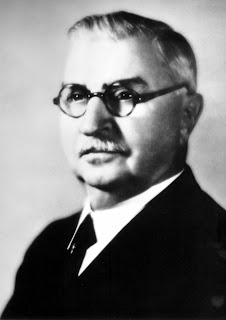 |
| Ewald Max Hoyer |
Barely qualified as a hamlet, those living in the community lived without electricity, gas, and a water system. Hoyer and the other residents would have to drive their buggies over to Shreveport to purchase a barrel of drinking water for 50 cents from a place called Curry Springs. By 1902, he tired of this, so he drilled the first deep-water well in Bossier Parish.
Hoyer and other pioneers of this city worked to build up their small community. Hoyer was a prominent businessman owning and operating a thriving dairy business with his brother Charles in Bossier City since 1893. By 1903 they built the largest dairy barn in North Louisiana, owned 100 cows, and by 1907, they were selling nearly 7,500 gallons of milk per month.
Advertisements from the Bossier City Land and Town Company repeatedly appeared in local newspapers in 1904. These ads were selling the growth potential of Bossier City and referring to it as East Shreveport to connect itself to the much larger and well-known city. In addition, they held auctions for over 700 lots in which they offered free transportation to and from the sale from the Shreveport end of the bridge. They also provided free barbecue and music.
And to sweeten the pot, they also offered the chance for any adult attending the auction to win one of three lots. And a round trip railroad ticket to the World's Fair, St. Louis Exposition would be given to the person whose purchases aggregate the largest amount. With the coming of the VS&P railroad, the growth potential was there, and the community members wasted no time in the work required to build their community.
1907 was an exciting year because all of their work paid off as Bossier City was incorporated and proclaimed a village by Governor Newton Crain Blanchard. In his proclamation, he appointed Hoyer as the first Mayor of Bossier City, based on the recommendations of leading businessmen in Bossier City and Shreveport.
That same year Bossier City's first city hall was built with Hoyer's money for $1,200 on a lot donated by William McCormick. He also advanced money to cover expenses of the new government, which the village later reimbursed. Hoyer was instrumental in securing federal funds to build the toll-free traffic bridge across the Red River. The first elections in Bossier City took place in 1909, where Hoyer was re-elected to serve a second term as mayor. The first school and the first Baptist church were built during his second term.
Hoyer never received a salary for his service as mayor. When his wife became ill, he left office, and they moved to Shreveport. And even after moving to Shreveport, Hoyer continued his interests in Bossier City, building several subdivisions. During the Great Depression, he recalled things were tough, but he held on to his belief in Bossier City's growth.
Hoyer was there when Governor John M. Parker made Bossier City a town in 1923. And, twenty-eight years later, he was there when Bossier City was proclaimed a city in 1951 by Governor Earl K. Long. Hoyer was 88 years old and was honored at Bossier Cities celebration of becoming a city. He reminisced about the sparse community he moved to in 1893 and how he watched it grow from a handful of families to over 15,000 residents.
By 1950, Bossier City was designated as the "Fastest Growing City in Louisiana." When Hoyer died in 1957, the estimated population was 25,000. Bossier City's current estimated population is over 68,000, and we are the 6th largest city in Louisiana. Hoyer and other hard-working pioneers that were not afraid of investing their time, energy, and money would be proud to see this great city today.
By: Amy Robertson
No comments:
Post a Comment